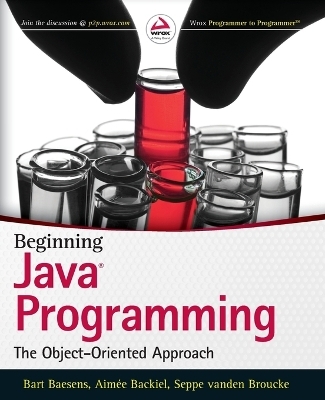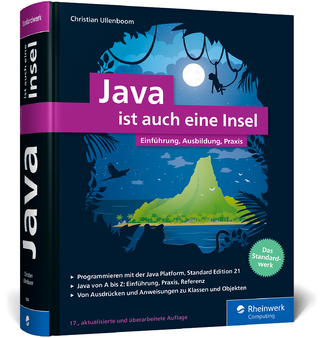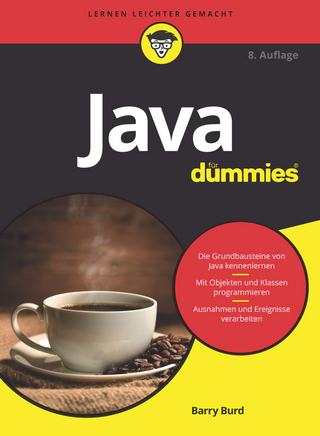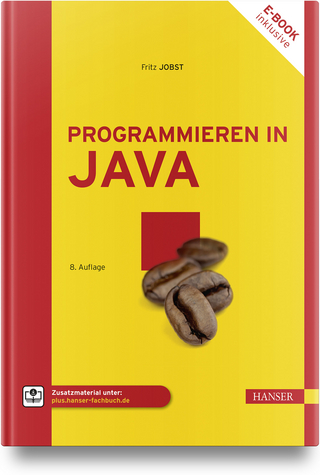
Beginning Java Programming
Wrox Press (Verlag)
978-1-118-73949-5 (ISBN)
A comprehensive Java guide, with samples, exercises, case studies, and step-by-step instruction Beginning Java Programming: The Object Oriented Approach is a straightforward resource for getting started with one of the world's most enduringly popular programming languages. Based on classes taught by the authors, the book starts with the basics and gradually builds into more advanced concepts. The approach utilizes an integrated development environment that allows readers to immediately apply what they learn, and includes step-by-step instruction with plenty of sample programs. Each chapter contains exercises based on real-world business and educational scenarios, and the final chapter uses case studies to combine several concepts and put readers' new skills to the test.
Beginning Java Programming: The Object Oriented Approach provides both the information and the tools beginners need to develop Java skills, from the general concepts of object-oriented programming. Learn to:
Understand the Java language and object-oriented concept implementation
Use Java to access and manipulate external data
Make applications accessible to users with GUIs
Streamline workflow with object-oriented patterns
The book is geared for those who want to use Java in an applied environment while learning at the same time. Useful as either a course text or a stand-alone self-study program, Beginning Java Programming is a thorough, comprehensive guide.
About the authors Bart Baesens is a professor at KU Leuven and a lecturer at the University of Southampton, where he teaches various programming and database management courses. Aimée Backiel is a doctoral researcher at KU Leuven. She teaches basic programming in Java to learners from diverse backgrounds. Seppe vanden Broucke is a postdoctoral researcher at KU Leuven. He uses Java daily, giving him insight into useful applications for practitioners. Visit us at wrox.com where you have access to free code samples, Programmer to Programmer forums, and discussions on the latest happenings in the industry from around the world.
Introduction xxii
Chapter 1: A General Introduction To Programming 1
The Programming Process 2
Object-Oriented Programming: A Sneak Preview 5
Programming Errors 6
Syntax/Compilation Errors 6
Runtime Errors 6
Logic/Semantic Errors 7
Principles of Software Testing 7
Software Maintenance 8
Adaptive Maintenance 8
Perfective Maintenance 8
Corrective Maintenance 8
Preventive Maintenance 9
Principles of Structured Programming 9
Chapter 2: Getting To Know Java 11
A Short Java History 12
Features of Java 13
Looking Under the Hood 13
Bytecode 14
Java Runtime Environment (JRE) 15
Java Application Programming Interface (API) 16
Class Loader 17
Bytecode Verifier 18
Java Virtual Machine (JVM) 18
Java Platforms 19
Java Applications 19
Standalone Applications 19
Java Applets 20
Java Servlets 20
Java Beans 21
Java Language Structure 21
Classes 22
Identifiers 22
Java Keywords 22
Variables 23
Methods 23
Comments 24
Naming Conventions 26
Java Data Types 27
Primitive Data Types 27
Literals 28
Operators 29
Arithmetic Operators 29
Assignment Operators 30
Bitwise Operators 31
Logical Operators 32
Relational Operators 34
Arrays 34
Type Casting 37
Summary 40
Chapter 3: Setting Up Your Development Environment 41
Integrated Development Environments 42
Coding in Text Editors 42
Choosing an IDE 46
Eclipse 47
NetBeans 47
IntelliJ IDEA 47
Continuing with One IDE 47
Installing Eclipse on Your Computer 48
Downloading and Installing Eclipse 48
Using Eclipse 50
Chapter 4: Moving Toward Object‐Oriented Programming 61
Basic Concepts of Object‐Oriented Programming 62
Classes and Objects in Java 63
Defining Classes in Java 63
Creating Objects 71
Storing Data: Variables 76
Instance Variables 76
Class Variables 80
Final Variables 82
Variable Scope 87
Defining Behavior: Methods 91
Instance Methods 91
Class Methods 94
Constructors 95
The Main Method 100
Method Argument Passing 109
Java SE Built‐in Classes 115
Classes in the java.lang Package 115
Classes in the java.io and java.nio Packages 117
Classes in the java.math Package 118
Classes in the java.net, java.rmi, javax.rmi, and org.omg.CORBA Packages 118
Classes in the java.awt and javax.swing Packages 118
Classes in the java.util Package 118
Collections 119
Other Utility Classes 126
Other Classes and Custom Libraries 127
Chapter 5: Controlling the Flow of Your Program 129
Comparisons Using Operators and Methods 130
Comparing Primitive Data Types with Comparison Operators 130
Comparing Composite Data Types with Comparison Methods 132
Understanding Language Control 135
Creating if-then Statements 135
Nesting if-then Statements 137
Creating for Loops 138
What is an Enhanced for Loop? 143
Nesting for Loops 146
Creating while Loops 148
What is a do while Loop? 152
Comparing for and while Loops 156
Creating Switches 156
Comparing Switches and if-then Statements 161
Reviewing Keywords for Control 162
Controlling with the return Keyword 162
Controlling with the break Keyword 163
Controlling with the continue Keyword 164
Specifying a Label for break or continue Control 164
Reviewing Control Structures 168
Chapter 6: Handling Exceptions and Debugging 171
Recognizing Error Types 172
Identifying Syntax Errors 172
Identifying Runtime Errors 175
Identifying Logical Errors 176
Exceptions 180
Common Exceptions 181
Catching Exceptions 187
Debugging Your Applications 195
Using a Debugger Tool 195
Using a Logging API 200
Testing Your Applications 210
Summary 219
Chapter 7: Delving Further Into Object‐Oriented Concepts 221
Annotations 222
Overloading Methods 222
The this KeyWord 224
Information Hiding 229
Access Modifiers 230
Getters 231
Setters 232
Class Inheritance 240
The Keyword super 241
Method Overriding 243
Polymorphism 243
Static Binding 244
Dynamic Binding 244
The Superclass Object 245
Abstract Classes and Methods 246
Packages 251
Interfaces 252
Garbage Collection 259
Chapter 8: Handling Input and Output 261
General Input and Output 262
Input and Output in Java 266
Streams 268
Byte Streams 269
Character Streams 275
Buffered Streams 276
Data and Object Streams 278
Other Streams 281
Scanners 281
Input and Output from the Command-Line 283
Input and Output from Files 290
Java NIO2 File Input and Output 291
The Path Interface 291
The Files Class 293
Checking Existence 293
Legacy File Input and Output 304
A Word on FileUtils 305
Conclusion 305
Chapter 9: Working With Databases in Java 307
Covering the Basics of Relational Databases 308
Accessing Relational Databases from Java 315
Java Database Connectivity (JDBC) 315
SQLJ 321
Ensuring Object Persistence 324
Hibernate 325
Object-Oriented Database Access from Java 341
Comparing Java Database Access Technologies 343
What’s Ahead 344
Chapter 10: Accessing Web Sources 347
A Brief Introduction to Networking 348
Web Services 360
RPC and RMI 360
SOAP 364
REST 366
Accessing Web Services and Sources with Java 368
Accessing SOAP Services 368
Installing JAX‐WS 368
Accessing SOAP Services with JAX‐WS Without WSDL 369
Accessing SOAP Services with JAX‐WS with WSDL 395
Accessing REST Services 406
Accessing REST Services Without Authentication 408
Accessing REST Services with Authentication 421
Screen Scraping 449
Screen Scraping Without Cookies 451
Screen Scraping with Cookies 453
Creating Your Own Web Services with Java 457
Setting Up an HTTP Server 457
Providing REST Services 461
Chapter 11: Designing Graphical Interfaces 463
Covering the Basics of GUIs in Java 464
Highlighting the Built‐In GUI Libraries 464
Abstract Window Toolkit (AWT) 464
Swing 464
Standard Widget Toolkit (SWT) 465
JavaFX 465
Other Toolkits and Libraries 466
Choosing a GUI Library 466
Building with Containers and Components 467
Looking at the Full Picture 472
Comparing Layout Managers 473
FlowLayout 474
BorderLayout 476
GridLayout 478
GridBagLayout 482
CardLayout 486
BoxLayout 489
GroupLayout and SpringLayout 493
Absolute Positioning (No Layout Manager) 494
Understanding Events 496
Introduction to Events 496
Event Listeners 497
On Threading and Swing 514
Closing Topics 524
Best Practices: Keeping Looks and Logic Separated 524
Let’s Draw: Defining Custom Draw Behavior 525
Visual GUI Designers: Making Life Easy? 540
JavaFX: The Road Ahead? 545
Chapter 12: Using Object‐Oriented Patterns 557
Introduction to Patterns 558
Object‐Oriented Patterns 558
Creational Patterns 559
Singleton Pattern and Static Utility Class 559
Service Provider Pattern and Null Object Pattern 565
(Abstract) Factory Pattern 566
Structural Patterns 568
Adapter Pattern 568
Bridge Pattern 570
Decorator Pattern 571
Facade Pattern 574
Composite Pattern 575
Type Pattern and Role Pattern 583
Behavioral Patterns 591
Chain‐of‐Responsibility Pattern 591
Observer Pattern and Model‐View‐Controller Pattern 592
Iterator Pattern 605
Visitor Pattern 607
Template Method Pattern 610
Strategy Pattern 612
Helpful Libraries 614
Apache Commons 614
Google Guava 615
Trove 615
Colt 615
Lombok 616
OpenCSV 616
HTML and JSON Libraries 616
Hibernate and Other JPA‐Compliant Libraries 617
Joda‐Time 617
Charting Libraries 617
3D Graphics Libraries 617
Financial Libraries 618
Index 619
| Sprache | englisch |
|---|---|
| Maße | 185 x 231 mm |
| Gewicht | 1066 g |
| Themenwelt | Informatik ► Programmiersprachen / -werkzeuge ► Java |
| Informatik ► Software Entwicklung ► Objektorientierung | |
| ISBN-10 | 1-118-73949-3 / 1118739493 |
| ISBN-13 | 978-1-118-73949-5 / 9781118739495 |
| Zustand | Neuware |
| Informationen gemäß Produktsicherheitsverordnung (GPSR) | |
| Haben Sie eine Frage zum Produkt? |
aus dem Bereich


